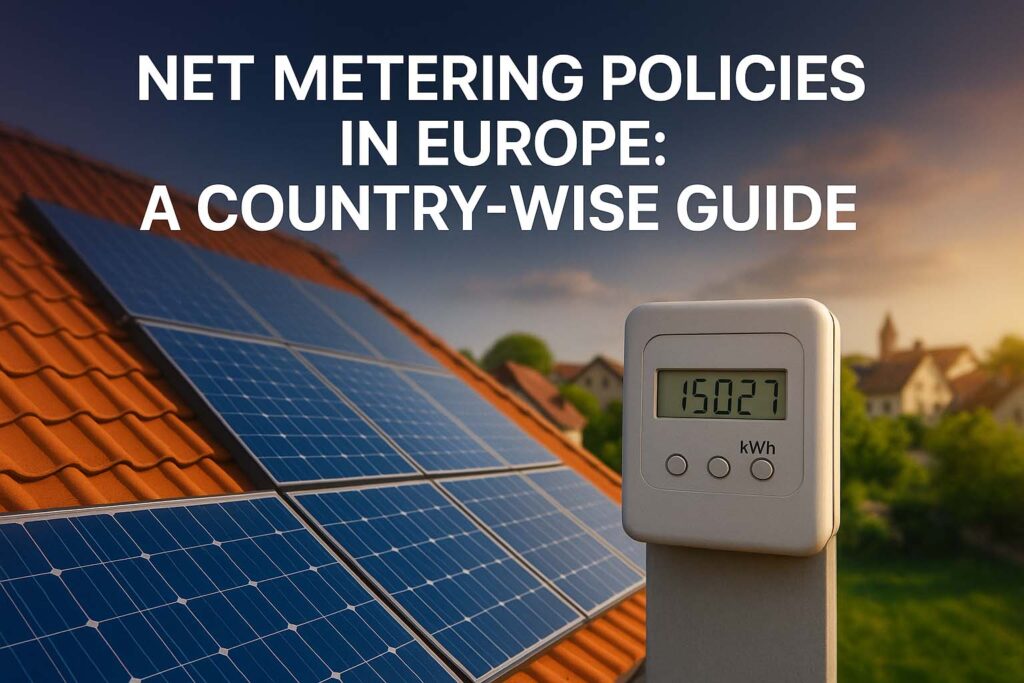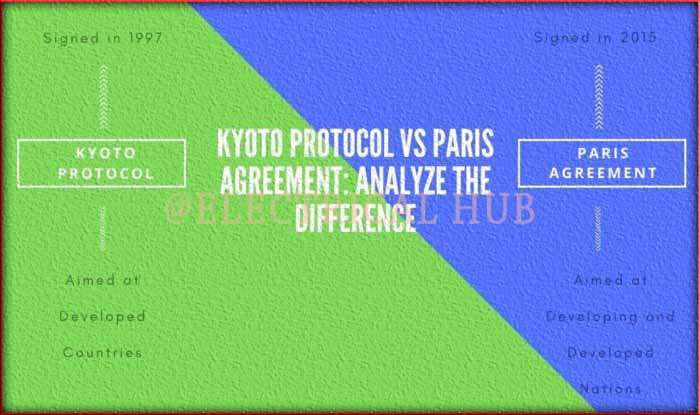Net Metering Policies in Europe: A Country-wise Guide
As solar adoption continues to rise across Europe, understanding Net Metering Policies in Europe becomes crucial for homeowners, businesses, and energy professionals. Net metering allows solar power users to feed excess electricity back into the grid in return for compensation or energy credits.

This article explores how different European countries approach net metering, providing a country-by-country analysis of regulations, incentives, and limitations. Whether you’re considering solar installation or evaluating energy ROI, this guide helps you navigate the evolving net metering landscape in Europe.
What is Net Metering?
Net metering is a billing mechanism that credits solar energy system owners for the electricity they add to the grid. When a solar system produces more electricity than the property consumes, the surplus is fed into the utility grid. Depending on the policy, users receive energy credits or financial compensation, which can offset future electricity costs.
In Europe, net metering policies differ widely between countries. Some have generous compensation schemes, while others offer limited or no net metering at all. These policies significantly affect the economics of residential and commercial solar energy systems.
Know more about Solar System Sizing Calculator for Tubewells
Overview of Net Metering Policies in Europe
The table below summarizes the net metering status across selected European countries:
| Country | Net Metering Available | Type of Compensation | System Size Limitations |
|---|---|---|---|
| Germany | No (Feed-in Tariff instead) | Fixed Feed-in Tariff | < 100 kW |
| France | Yes | Energy Credit (monthly) | Up to 36 kVA |
| Italy | Yes | Net Billing (Scambio sul posto) | Up to 500 kW |
| Spain | Yes | Net Billing | Up to 100 kW |
| UK | No (Smart Export Guarantee) | Market-based rate | No defined upper limit |
| Netherlands | Yes (to be phased out) | Full Retail Credit | Up to 15 kWp |
| Belgium | Yes (in Flanders, ending 2025) | Retail Credit | < 10 kW (Flanders) |
| Sweden | Yes | Financial Compensation | < 100 A per phase |
| Austria | Yes | Net Billing | Up to 100 kW |
| Greece | Yes | Energy Credit | Up to 3 MWp (non-commercial) |
Germany: Feed-in Tariff over Net Metering
Germany does not follow a typical net metering model. Instead, it operates under a feed-in tariff system. Residential solar system owners are paid a fixed rate for the electricity they inject into the grid. The compensation is guaranteed for 20 years. System owners can self-consume their generated energy and sell the surplus. This model has been successful in encouraging solar deployment but does not allow direct energy credit offsetting. Therefore, Net Metering Policies in Europe differ notably in Germany compared to its neighbors.
Know more about Off-Grid Solar System Design Guide for Remote Areas
France: Monthly Energy Credit
France implements a simplified version of net metering through a program called “autoconsommation avec injection du surplus.” Households with solar installations can consume their generated energy and send excess electricity to the grid.
The surplus is compensated either through a feed-in tariff or as an energy credit depending on the agreement. For systems under 9 kWp, the process is streamlined and financially attractive. The government also offers subsidies for system installations, making the French model a progressive example among Net Metering Policies in Europe.
Italy: Net Billing System
Italy operates a system known as Scambio sul posto, which functions similarly to net billing rather than pure net metering. Consumers receive monetary compensation for the energy exported to the grid, but at a lower rate than the retail price. This mechanism promotes self-consumption while still offering returns for surplus generation. Italy also offers tax incentives for solar installations.
The compensation is calculated annually, and system owners can expect partial cost recovery over time. Italy’s model encourages both residential and small-scale commercial solar adoption.
Spain: Resurgence of Net Metering
Spain once had a controversial “sun tax,” but it was repealed in 2019. Since then, the country has embraced a net billing system that compensates users for exported energy. Residential and commercial users up to 100 kW can benefit. The compensation rate is based on wholesale market prices.
Know more about MPPT vs PWM Charge Controller: Which One is Better?
While not full net metering, it’s still an attractive model due to high solar irradiation and falling solar PV costs. Additionally, group self-consumption and community solar projects are legally supported, strengthening Spain’s position in the realm of Net Metering Policies in Europe.
United Kingdom: Smart Export Guarantee
The UK discontinued its net metering scheme in 2019 and introduced the Smart Export Guarantee (SEG). Under SEG, licensed electricity suppliers offer payments for surplus solar energy exported to the grid. Rates are not fixed and vary by provider.
Unlike traditional net metering, there is no credit against consumption, only compensation for exported units. This market-based approach encourages price competition among suppliers. System owners must install a smart meter and meet minimum technical requirements.
Netherlands: Full Retail Credit (Phasing Out)
The Netherlands offers one of the most generous net metering policies in Europe. Solar users receive full retail credit for every unit of electricity fed into the grid, essentially allowing 1:1 offsetting. This policy has made residential solar systems highly popular.
However, the government plans to phase out the scheme starting in 2025, with a gradual reduction of benefits until 2031. A new incentive structure will likely replace it, potentially shifting towards net billing. Therefore, current benefits under the Net Metering Policies in Europe in the Netherlands are time-sensitive.
Belgium: Regional Variations
Belgium’s net metering policy varies by region. In Flanders, a net metering scheme is in place but is scheduled to end in 2025. System owners currently receive retail value for exported energy under 10 kW. Wallonia and Brussels operate differently, often leaning toward net billing or offering capacity-based incentives.
Grid balancing charges are under discussion, especially as self-consumption increases. Belgium’s policy framework reflects the complexity of aligning net metering with grid stability goals.
Know more about Battery Energy Storage System Design and ROI
Sweden: Compensation Based on Grid Impact
Sweden does not offer net metering in the traditional sense. However, small-scale producers receive financial compensation for electricity fed into the grid, often through agreements with electricity providers. Systems with fuse ratings under 100 A per phase are eligible. The government exempts self-consumed solar from energy tax, making on-site use more appealing. Unlike other countries, Sweden focuses on energy independence and grid stability rather than full offsetting, a trend seen in Nordic Net Metering Policies in Europe.
Austria: Progressive Net Billing
Austria supports net billing for small-scale producers. Solar energy fed into the grid is compensated at a market-linked rate, while users pay the standard retail rate for consumed electricity. The system favors high self-consumption, with financial incentives for battery storage. Grid operators provide annual compensation statements. Austria’s policy is simple and encourages energy efficiency, fitting well with EU decarbonization goals.
Greece: High Capacity Limits
Greece has one of the most flexible net metering policies in Europe. Both residential and commercial systems are allowed, with capacity limits up to 3 MW for non-commercial users. The program works through energy credits that can offset future electricity bills within a three-year period. Grid connection rules are strict, but the financial viability is strong due to high solar yields. The Greek government actively promotes solar through tax incentives and subsidized financing.
Know more about Hybrid Solar Inverter Working Principle with Circuit Diagram
Key Observations from Net Metering Policies in Europe
- Most Western European countries have shifted toward net billing rather than full net metering.
- Eastern and Southern Europe show more generous compensation to accelerate solar adoption.
- Countries with grid capacity concerns are phasing out or capping retail credit systems.
- There is a growing trend toward self-consumption, battery storage, and dynamic pricing models.
- Regulatory consistency is lacking, making pan-European solar investment complex.
Final Thoughts
Net Metering Policies in Europe play a critical role in the economics of solar power. As each country takes a unique approach, understanding local regulations becomes essential for system designers, investors, and homeowners. The overall trend is moving away from traditional net metering toward net billing and dynamic export pricing. For those considering solar installations, the timing, system size, and policy structure can greatly affect ROI.
Know more about How to Calculate Solar Plant Efficiency in 5 Steps
As Europe continues to align with its climate goals, net metering policies will evolve. Staying informed about national updates ensures that consumers and businesses can make smart energy decisions. Whether you are in France enjoying monthly credits or in the UK navigating SEG rates, solar adoption remains a financially and environmentally sound choice.
Follow Us on Social:
Subscribe our Newsletter on Electrical Insights for latest updates from Electrical Engineering Hub
#NetMeteringEurope, #RenewableEnergy, #SolarPolicy, #EnergySavings, #GreenEnergyEurope, #NetMeteringGuide, #SustainableLiving, #SolarEnergyEurope, #CleanEnergy, #EnergyTransition, #NetMeteringExplained, #EuropeanEnergyPolicy, #SolarPowerPolicy, #EcoFriendlySolutions, #NetMeteringBenefits




